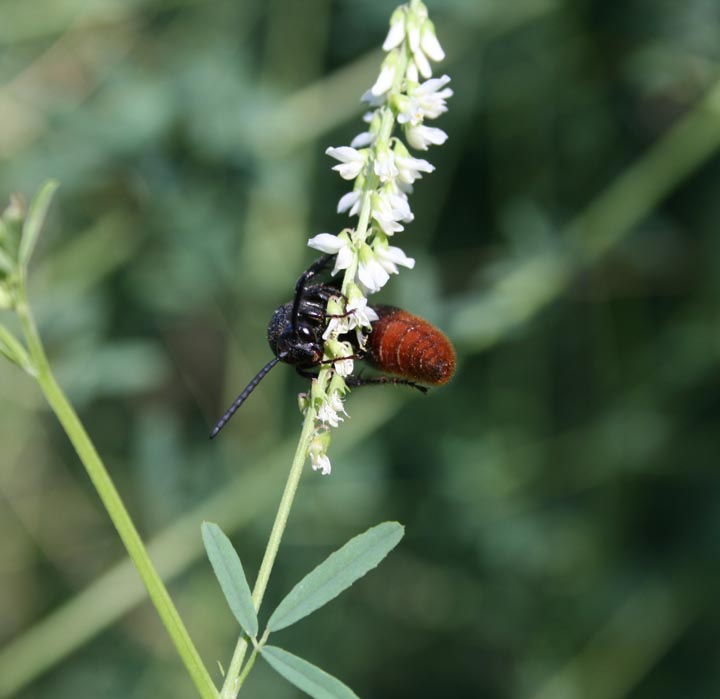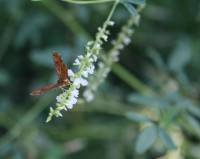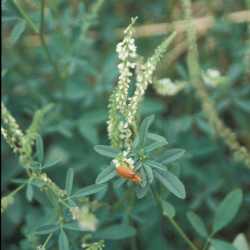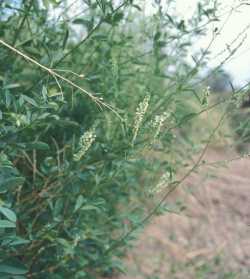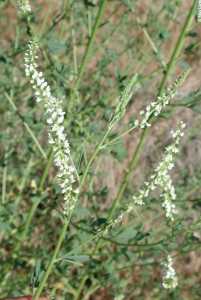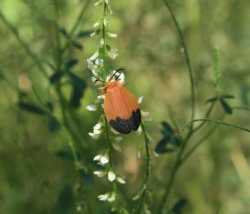|
|
|
|
Family: Fabaceae
[Melilotus alba Medik., moreMelilotus leucanthus DC.] |
Erect, taprooted biennial (annual) 1-3 m; lfls lanceolate or oblanceolate to narrowly oblong or rarely ovate, 1-2.5 cm; racemes numerous, 5-20 cm (peduncle included); pedicels 1-2 mm; fls white, 3.5-5(-6) mm, the banner distinctly longer than the wings; ovules 2-4; fr 2.5-3 mm, reticulate-veiny; seeds 1 or 2; 2n=16. Native of Eurasia, established as a weed along roadsides and in waste places, especially in calcareous soil, from N.S. to B.C., s. to Mex. and W.I. Summer and fall. Gleason, Henry A. & Cronquist, Arthur J. 1991. Manual of vascular plants of northeastern United States and adjacent Canada. lxxv + 910 pp. ©The New York Botanical Garden. All rights reserved. Used by permission. Jepson 2012, Kearney and Peebles 1969 Duration: Annual Nativity: Non-Native Lifeform: Forb/Herb General: Herbaceous annuals, biennials or perennials, to 2 m tall, stems erect, herbage glabrous to strigose. Leaves: Alternate, pinnate with 3 leaflets, leaflets elliptic-oblong to obovate, 1-2.5 cm long with toothed margins, blades petiolate with narrow or bristle-like stipules with the bases fused to the petioles. Flowers: Small, white, pendant, with banner, wing, and keel petals, corollas 3.5-5 mm long, sepals generally 5, generally fused, calyx to 2 mm long, stamens 10 with 9 filaments fused and the uppermost 1 free, pistil 1, style, stigma 1, ovary superior, generally 1-chambered, ovules 1-many, hypanthium 0 or flat to tubular, inflorescences in axillary or terminal, slender, many-flowered racemes. Fruits: Indehiscent, ovate legumes, 3.5 mm long, indehiscent, 2-4 mm long, compressed, thick and leathery, surfaces with a visible network of veins. Seeds 1 per legume. Ecology: Found in pastures, open and disturbed areas, to 6,500 ft (1981 m); flowering May-September. Distribution: Throughout N. Amer., in every state in the U.S.; south to S. Amer.; throughout the world on every continent. Notes: This pretty plant can be small and delicate or become tall, bushy and open branching, with long, slender inflorescences adorned with pendant, ranked, white, bell-like flowers and 3-lobed leaves, the leaflets with toothed margins. Differs from the other Melilotus species by the white flowers. Ethnobotany: Specific uses for this species are unknown, but other species in the genus have uses; leaves dried, ground, placed in a small bundle and tied onto women's clothes as a perfume. Synonyms: Melilotus leucanthus Editor: LCrumbacher 2012, FSCoburn 2015 Etymology: Melilotus comes from the Greek words meli, "honey," and lotos, a leguminous plant; the meaning of albus is unknown. |


